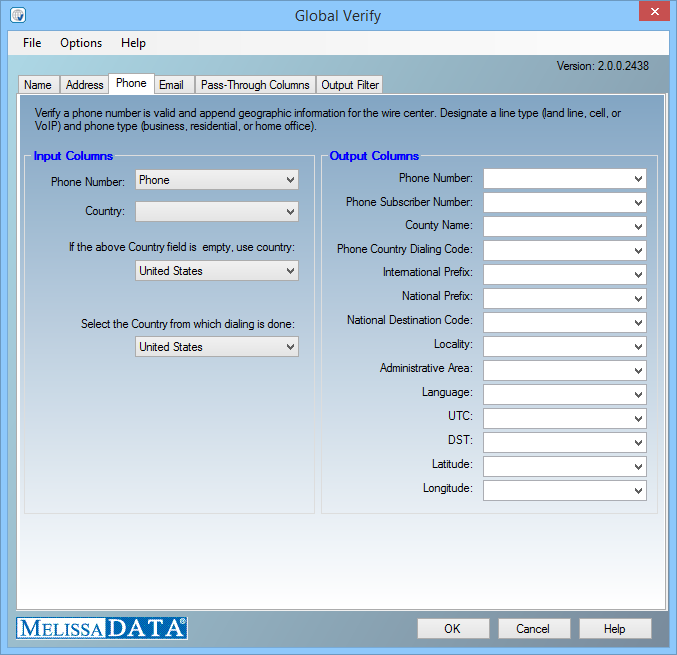This wiki is no longer being updated as of December 10, 2025.
|
SSIS:Global Verify:Phone
Jump to navigation
Jump to search
← SSIS:Data Quality Components
| Global Verify Navigation | |||||||
|---|---|---|---|---|---|---|---|
| Overview | |||||||
| Tutorial | |||||||
| |||||||
| |||||||
|

Verify a phone number as valid and append geographic information for the wire center.
Input Columns
- Phone Number
- The phone number for the input column.
- Country
- The country name or code associated with the input phone number.
- If the above Country field is empty, use country
- Use this if no Country field is specified or a record's country field is blank.
- Select the Country from which dialing is done
- Specify the Country the dialing is done from.
Output Columns
- Phone Number
- The standardized output phone number.
- Phone Subscriber Number
- The subscriber number associated with the inputted phone number. The subscriber number contains significant leading digits that further define the local exchange area and/or service.
- County Name
- The name of the country for the inputted phone number.
- Phone Country Dialing Code
- A digit, or combination of digits dialed after the international prefix.
- International Prefix
- The international exit code needed to call a number outside of the dialing country. If the input country and country of origin differ, this will return the digit(s) required to be dialed before the country code.
- National Prefix
- A digit, or combination of digits that must be dialed before an area (city) code when calling a number within the same country but outside the numbering area.
- National Destination Code
- A digit, or combination of digits that identifies a numbering area within a country (or group of countries) and/or network/services.
- Locality
- City. The locality associated with the inputted phone number.
- Administrative Area
- State. The administrative area associated with the inputted phone number.
- Language
- The predominant language of the phone’s detected geographical location.
- UTC
- The universal time code for the time zone associated with the inputted phone number. The format will be: +/- hh:mm.
- DST
- Daylight Savings Time. Returns a ‘Y’ (for yes) or ‘N’ (for no) to distinguish whether the region of the inputted phone number observes daylight savings time.
- Latitude
- The geographic coordinate of the locale, city, municipality, or other geographically identifiable service area of the exchange measured in degrees north or south of the equator.
- Longitude
- The geographic coordinate of the locale, city, municipality, or other geographically identifiable service area of the exchange measured in degrees east or west of the Greenwich Meridian.
- Carrier
- Returns the name of the phone’s carrier.
- Country Abbreviation
- Returns the abbreviation of the country for the inputted phone number.
- International Phone Number
- This is the number you would dial, given your output fields, in order to successfully send a call. This number can change based on whether a Country of Origin is submitted or not.
- Postal Code
- The zip code that corresponds to a locality inside the United States. Since this is US only, all other countries will have PostalCode blank.
Phone Number Verification Options
- Express Mode
- This option will do the following lookups in the order shown:
- ITED lookup
- Cassandra MasterPhone cache lookup (check HLR Country Coverage section for more info).
- Premium Mode
- This option will do the following lookups in the order shown:
- ITED lookup
- Cassandra MasterPhone cache lookup
- If the phone belongs in a country that our third-party vendor supports Active Line validation for* AND lookup is more than 30 days, then do HLR lookup
- DefaultCallingCode
- Is used when the country could not be detected from the phone number or country input. A calling code is a sequence of digits often found after the leading ‘+’ and is unique to a country/region. By default, this value is blank. For more information on country calling codes, please see https://en.wikipedia.org/wiki/List_of_country_calling_codes.